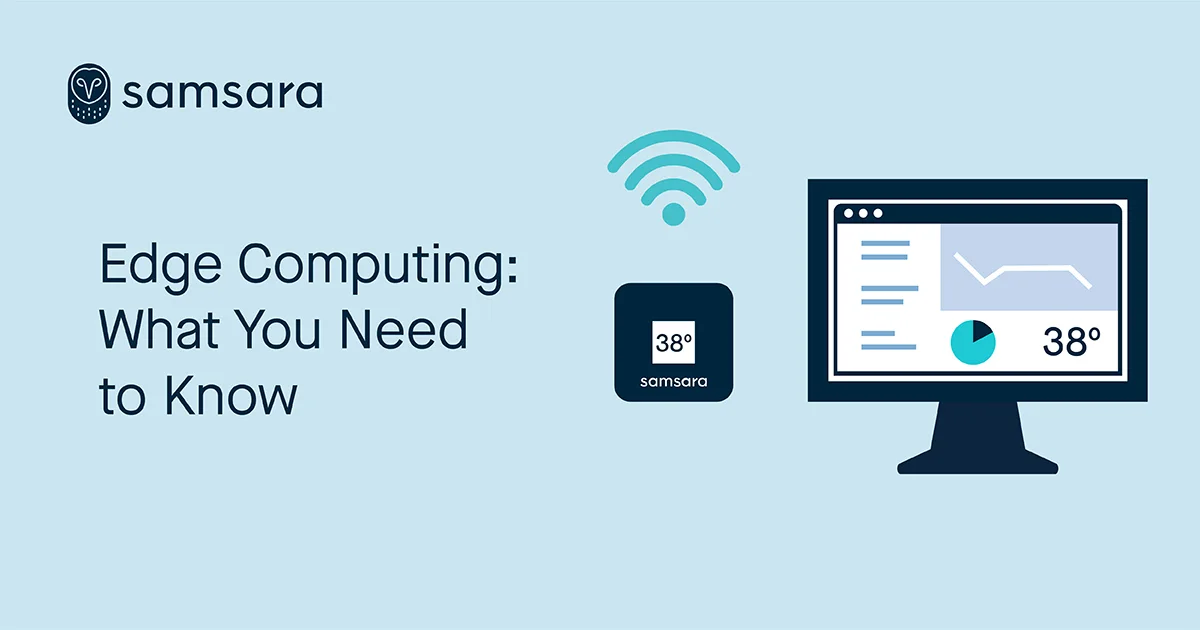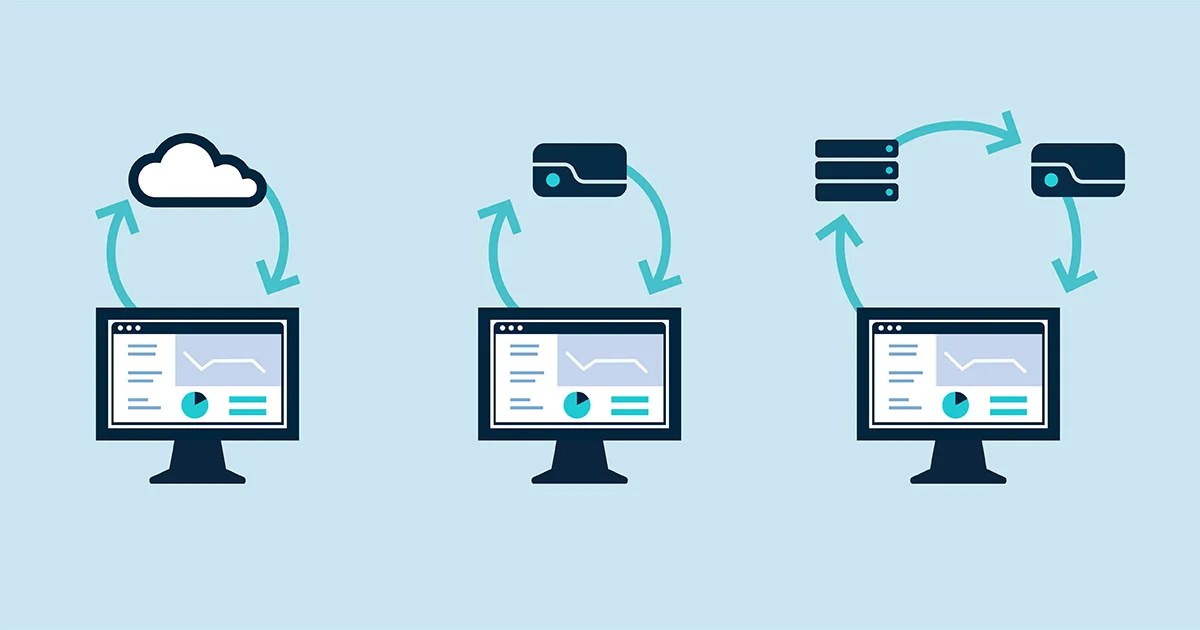What is Edge Computing?
April 29, 2020

Get Started with Samsara
Check Our PricesKey Takeaways
Get all of the details on how edge computing works, why it matters for fleets, and the future of industrial IoT all in this comprehensive guide.
What is edge computing?
Edge computing is the practice of processing data in a location that is physically closer to its source. Named for the way it functions on the “edges” of devices or networks, it is used to reduce processing delays and to streamline operations as much as possible. This results in faster data processing, improved security, lower costs, and decreased risks of outages.
Applications that rely on instantaneous feedback, such as industrial machines or autonomous vehicles, benefit greatly from edge computing. As an example, in the event of changing road conditions or potential hazards, it is critical for self-driving cars to react immediately. Saving mere milliseconds of data processing and response time can be critical in avoiding costly accidents.
On a larger scale, edge computing’s faster and more reliable processing power allows companies to explore new business opportunities, increase operational efficiency, and improve their user experience.
Why does edge computing matter?
As the use of Internet of Things (IoT) devices—any device capable of accessing the internet—becomes more prevalent, the amount of data collected continues to increase as well. According to cloud service company, DOMO, “Over 2.5 quintillion bytes of data are created every single day.” Seagate’s Data Age 2025 study shows that by 2025, almost 30% of data created will need to be analyzed in real time.
Though big data is becoming increasingly widespread,data sets are too large and complicated for conventional processing applications. Traditionally, data produced by IoT devices is relayed back to a network server inside a data center for processing. Data must then travel back to the device. This back and forth between a device and the network server results in inconvenient delays, causing even simple tasks to take extended amounts of time.
This method of processing data puts a large strain on bandwidth—the rate at which data is transferred over the internet. Bandwidth strain slows the process down even further and results in latency, the delay in sending information from one point to the next.
Distance also increases travel time for data just as it does for physical packages. The farther you are physically located from the server, the more network latency you will experience. To achieve low latency, data has to be processed closer to its source.
By processing data at the network edge, edge computing reduces the need for large amounts of data to travel between servers and their end users, solving the issues found in conventional data processing. This modern computing method provides businesses with new opportunities to innovate through its high efficiency in data collection and analysis.
What is the difference between cloud, edge, and fog computing?
While these methods of computing are often used together to provide strengthened computing power, they are distinctively different:
Cloud computing uses a network of remote servers hosted on the internet.
Edge computing uses the edge of a device (or server).
Fog computing uses the local area network (LAN) of a network architecture.
Cloud computing has been the preferred method of data processing in recent years. It has been implemented by many businesses due to its capacity for strong computing power, elasticity, and ability to store and process data without physical hardware.
While cloud computing has many benefits, it is also limited by the speed of light and internet bandwidth. As the use of technological devices becomes increasingly widespread, the demand for faster and more reliable data processing is also increasing. The large amounts of data that users create and the rise of mobile devices has put a strain on cloud computing’s networking bandwidth.
To lighten this strain, edge computing has been incorporated into many IoT devices. Localizing data processing results in less information that needs to be sent to a cloud. This in turn frees up the bandwidth, reducing latency.
Closely related to edge computing, fog computing is a real-time data processing method that also pushes data and intelligence to local analytics platforms. It differs from edge computing in where it processes data. While edge computing functions directly on devices with sensors or gateway devices close to sensors, fog computing processes data on a device’s local area network (LAN). Within the LAN, data is processed in either a fog node or IoT gateway—devices that allow for fog computing.
In contrast with edge computing’s method of collecting data from a single touch point or set of devices, fog computing’s strength lies in its ability to collect data from different devices. It is also able to process more data than edge computing. Conversely, fog computing is limited by its connection to more devices, which requires more infrastructure and investment, and its reliance on a larger network.
These three computing methods—cloud, fog, and edge—complement each other. Fog computing improves edge capabilities to process real-time requests. Both fog and edge computing reduce the strain on cloud computing’s networking bandwidth by only sending select data to the cloud for storage or analysis.

Five benefits of edge computing
Organizations can benefit from edge computing in the following ways:
Reduced latency <br> Because edge computing processes data closer to its source, overall latency is greatly reduced. This results in faster data processing, which is essential when working with applications that require precision, accuracy, and most importantly, speed.
Improved security <br> With edge computing, a large amount of data is no longer exclusively processed in the public cloud. The public cloud is a cloud infrastructure owned by a cloud provider who sells access to different clients. Popular cloud providers include Amazon Web Services and Microsoft Azure. <br><br> As edge computing allows for information to be processed locally, the amount of sensitive data that needs to be transmitted to the cloud decreases. This reduces the risk of information being accessed by hackers or infected by viruses. The edge can effectively take the place of computation that happens in the private cloud.
Lower expenses <br> As the volume of internet-connected devices increases, so does the need for database resources. Upgrading your bandwidth and increasing data storage can become a very costly process. Edge computing ensures that only necessary information is uploaded to the cloud. As a result, data communication and storage expenses are lowered.
Greater functioning range <br> The range of cloud computing is limited by its requirement for internet access. Conversely, edge computing’s local data processing allows organizations to extend their services into remote locations, previously inaccessible.
Increased reliability <br> When applications operate exclusively on the cloud, they run the risk of experiencing a cloud outage. Outages can be caused by a number of reasons such as power loss, maintenance, or network connectivity issues. Unscheduled cloud outages can prove extremely costly for businesses, who can permanently lose important data or be unable to access data at a critical moment in time. Edge computing compensates for this weakness by processing data directly on the edge of a network or device, eliminating the need for transferring large amounts of data using the internet.
Edge computing and fleet management
According to a report by Gartner, 75% of all data will need analysis and action at the edge by the year 2025. The telematics industry is no exception. Telematics providers like Samsara are one step ahead in using edge computing in their products.
The Samsara dual-facing AI dash cam is one such example of efficient edge computing. It uses sensors, computer vision, and AI to analyze both the road and the driver on the edge. Through video analysis, edge computing identifies and documents safety-related events such as instances of high-risk driver behaviour or driver fatigue. It is able to distinguish these events from harmless ones, such as driving over bumps or sharp turns in the road.
Edge computing then selectively and automatically uploads recordings of relevant events to the cloud, giving fleet managers access. This is in contrast with simpler motion-triggered or loop recording dash cams, which may collect a backlog of irrelevant footage. Issues can then be addressed with features such as real-time driver assistance.
The benefit of edge computing for fleet management is not limited to detecting driver fatigue and distraction through dash cams. Working together with other data collected by telematics, Samsara’s fleet management solutions also allow for engine diagnostics, preventative maintenance, and harsh event detection. For example, Samsara can help predict truck breakdowns based on individualized data from the truck itself. Similarly, it contributes to collision prevention through alerting drivers of approaching vehicles and unsafe distancing.
Even data such as trailer temperatures can be analyzed and acted upon with edge computing in the Samsara EM21 Wireless Environmental Monitor. Edge computing allows the environmental monitor to collect data and to determine when trailers exceed a predetermined temperature range. This then allows the software to alert fleet managers to take the appropriate actions to reduce temperature-related cargo loss and damage claims for refrigerated trailers.
The future of industrial IoT with edge computing
As data increases in quantity and conventional data processing methods become less efficient, new methods such as edge computing are necessary for businesses to stay competitive. Selectively moving real-time data processing to the edge can assist companies in optimizing their networks by turning large data sets into actionable business intelligence. Companies like Samsara who have made this move provide an intelligent, cost-effective solution for their customers.
Recent advances in technology such as the 5G network, machine learning, and artificial intelligence will continue to shape the role of edge computing and enable new use cases. The Samsara AI dual-facing dash cam gives a glimpse of what to expect with edge computing works in the telematics industry.
To learn more about how edge computing has allowed Samsara to provide their customers with effective, forward-thinking systems, request a free trial here, or explore Samsara’s fleet management solutions.